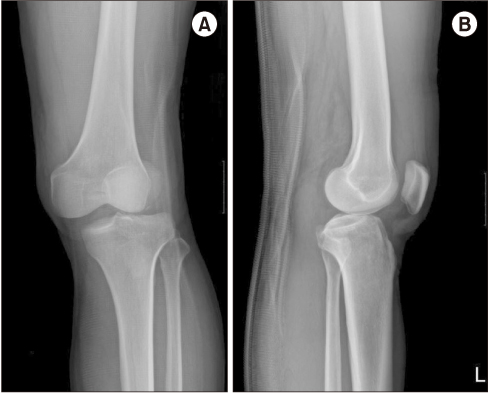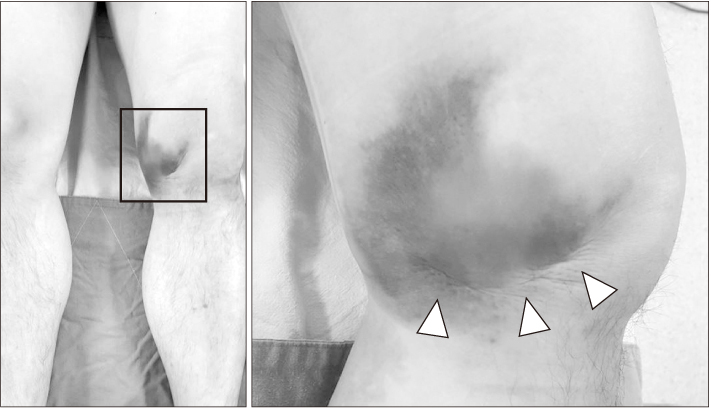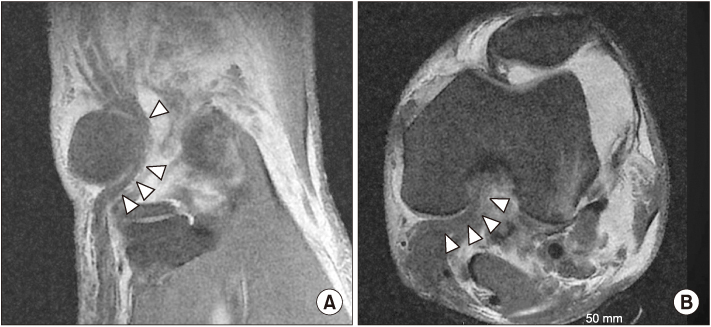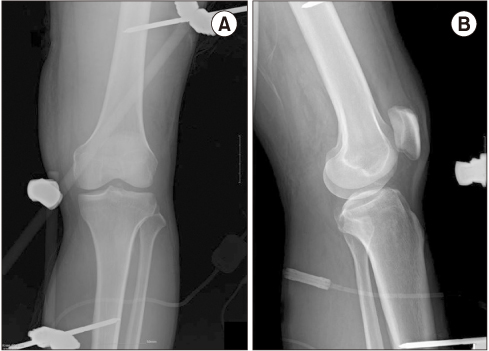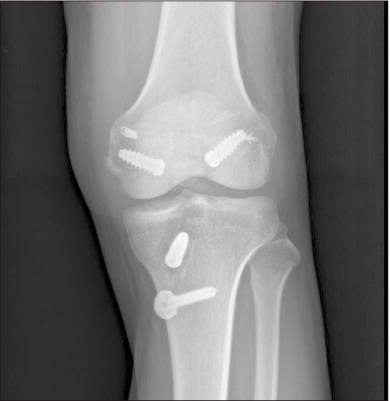J Korean Orthop Assoc.
2020 Feb;55(1):95-100. 10.4055/jkoa.2020.55.1.95.
Closed Reduction of Irreducible Posterolateral Rotatory Knee Dislocation
- Affiliations
-
- 1Department of Orthopedic Surgery, Yeouido St. Mary's Hospital, College of Medicine, The Catholic University of Korea, Seoul, Korea. ssewon@naver.com
- KMID: 2470775
- DOI: http://doi.org/10.4055/jkoa.2020.55.1.95
Abstract
- In general, most knee dislocations are reduced easily by simple traction. In rare cases, closed reduction of the knee dislocation is attempted, but ruptured ligaments or muscles are stuck in the joints and cannot be reduced. The cases of this irreducible knee dislocation have sometimes been reported. The authors encountered a case of irreducible knee posterolateral rotational dislocation that was not reduced by simple traction and report it along with a review of the literature. This case provides an opportunity for clinicians to examine the clinical considerations when experiencing an irreducible knee dislocation.
Figure
Cited by 1 articles
-
Open Reduction and Primary Ligament Suture for Irreducible Knee Dislocation: A Case Report
Je-Gyun Chon, Bong-Ju Lee, Seungha Woo
Korean J Sports Med. 2022;40(4):263-269. doi: 10.5763/kjsm.2022.40.4.263.
Reference
-
1. Kennedy JC. Complete dislocation of the knee joint. J Bone Joint Surg Am. 1963; 45:889–904.
Article2. Robertson A, Nutton RW, Keating JF. Dislocation of the knee. J Bone Joint Surg Br. 2006; 88:706–711.
Article3. Reckling FW, Peltier LF. Acute knee dislocations and their complications. 1969. Clin Orthop Relat Res. 2004; (422):135–141.4. Quinlan AG, Sharrard WJ. Postero-lateral dislocation of the knee with capsular interposition. J Bone Joint Surg Br. 1958; 40-B:660–663.
Article5. Bistolfi A, Massazza G, Rosso F, et al. Non-reducible knee dislocation with interposition of the vastus medialis muscle. J Orthop Traumatol. 2011; 12:115–118.
Article6. Durakbaşa MO, Ulkü K, Ermiş MN. Irreducible open posterolateral knee dislocation due to medial meniscus interposition. Acta Orthop Traumatol Turc. 2011; 45:382–386.7. Harb A, Lincoln D, Michaelson J. The MR dimple sign in irreducible posterolateral knee dislocations. Skeletal Radiol. 2009; 38:1111–1114.
Article8. Jeevannavar SS, Shettar CM. ‘Pucker sign’ an indicator of irreducible knee dislocation. BMJ Case Rep. 2013; 2013:bcr2013201279.
Article9. Kilicoglu O, Akman S, Demirhan M, Berkman M. Muscular buttonholing: an unusual cause of irreducible knee dislocation. Arthroscopy. 2001; 17:E22.10. Tateda S, Takahashi A, Aizawa T, Umehara J. Closed reduction of “irreducible” posterolateral knee dislocation - a case report. J Orthop Case Rep. 2016; 6:20–23.
- Full Text Links
- Actions
-
Cited
- CITED
-
- Close
- Share
- Similar articles
-
- Arthroscopic Reduction of Irreducible Posterolateral Knee Dislocation with Interposition of the Vastus Medialis: A Case Report
- Irreducible Posterolateral Dislocation of the Knee Joint with Lateral Dislocation of the Patella: A Report of Two Cases
- Open Reduction and Primary Ligament Suture for Irreducible Knee Dislocation: A Case Report
- Irreducible Knee Dislocation with Vastus Medialis Muscle Interposition
- An Irreducible Hip Dislocation with Femoral Head Fracture


